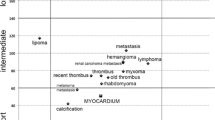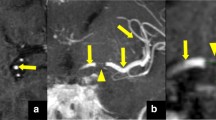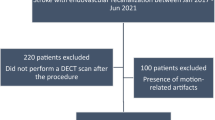Abstract
The objectives of this study were to evaluate the diagnostic value of delayed-enhancement cardiovascular magnetic resonance (DE-CMR) imaging in differentiating cardiac tumors from thrombi in patients with suspected cardio-embolic stroke. Two radiologists blinded to the study protocol retrospectively evaluated MR images of 22 patients (12 men and 10 women; mean age 59.2 years) that had recently experienced a stroke and undergone CMR. Six cardiac tumors and 16 thrombi were confirmed on surgery or follow-up examinations. On DE-CMR, a tumor was defined as an intracardiac mass showing post-contrast enhancement, and a thrombus was defined as an intracardiac mass showing black signal intensity (SI) without post-contrast enhancement. The mean SI in regions of interest in the normal myocardium and cardiac mass were measured using cine-CMR and DE-CMR. Visual assessment of enhancement characteristics of cardiac masses on DE-CMR could accurately differentiate cardiac tumors from thrombi in all cases. On cine-CMR, the mean SI ratios for tumors and thrombi were 1.45 ± 0.45 (range, 1.12–2.16) and 1.39 ± 0.33 (range, 0.87–2.09), respectively (P = 0.745). On DE-CMR, the mean SI ratios for tumors and thrombi were 5.65 ± 2.96 (range, 2.98–9.92) and 1.06 ± 0.43 (range, 0.67–1.95), respectively (P < 0.001). DE-CMR is a non-invasive modality for detecting intra-cardiac mass can differentiate tumors from thrombi in cardio-embolic stroke patients.




Similar content being viewed by others
Abbreviations
- DE-CMR:
-
Delayed-enhancement cardiovascular magnetic resonance
- CT:
-
Computed tomography
- CMR:
-
Cardiovascular magnetic resonance
- SI:
-
Signal intensity
- ROI:
-
Region of interest
- MI:
-
Myocardial infarction
- CVA:
-
Cerebrovascular accident
- LA:
-
Left atrium
- LV:
-
Left ventricle
- LAA:
-
Left atrial appendage
- b-FFE:
-
Balanced steady-state free precession
- TR:
-
Repetition time
- TE:
-
Echo time
- T1-TFE:
-
Segmented inversion recovery radiofrequency spoiled gradient echo
References
Wein TH, Bornstein NM (2000) Stroke prevention: cardiac and carotid-related stroke. Neurol Clin 18(2):321–341
Kolominsky-Rabas PL, Weber M, Gefeller O et al (2001) Epidemiology of ischemic stroke subtypes according to TOAST criteria: incidence, recurrence, and long-term survival in ischemic stroke subtypes: a population-based study. Stroke 32(12):2735–2740
Adams HP Jr, Bendixen BH, Kappelle LJ et al (1993) Classification of subtype of acute ischemic stroke. Definitions for use in a multicenter clinical trial. TOAST. Trial of Org 10172 in acute stroke treatment. Stroke 24(1):35–41
Murtagh B, Smalling RW (2006) Cardioembolic stroke. Curr Atheroscler Rep 8(4):310–316
Doufekias E, Segal AZ, Kizer JR (2008) Cardiogenic and aortogenic brain embolism. J Am Coll Cardiol 51(11):1049–1059
Ferro JM (2003) Cardioembolic stroke: an update. Lancet Neurol 2(3):177–188
Palazzuoli A, Ricci D, Lenzi C et al (2000) Transesophageal echocardiography for identifying potential cardiac sources of embolism in patients with stroke. Neurol Sci 21(4):195–202
Daniel WG, Mugge A (1995) Transesophageal echocardiography. N Engl J Med 332(19):1268–1279
Manning WJ, Weintraub RM, Waksmonski CA et al (1995) Accuracy of transesophageal echocardiography for identifying left atrial thrombi. A prospective, intraoperative study. Ann Intern Med 123(11):817–822
Hur J, Kim YJ, Nam JE et al (2008) Thrombus in the left atrial appendage in stroke patients: detection with cardiac CT angiography–a preliminary report. Radiology 249(1):81–87
Hur J, Kim YJ, Lee HJ et al (2009) Left atrial appendage thrombi in stroke patients: detection with two-phase cardiac CT angiography versus transesophageal echocardiography. Radiology 251(3):683–690
Jin KN, Chun EJ, Choi SI et al (2010) Cardioembolic origin in patients with embolic stroke: spectrum of imaging findings on cardiac MDCT. AJR Am J Roentgenol 195(1):W38–W44
Hwang JY, Choe YH (2011) Cardiovascular sources of systemic embolism: detection and characterization using multidetector CT and MR imaging. Int J Cardiovasc Imaging 27:727–744
Rustemli A, Bhatti TK, Wolff SD (2007) Evaluating cardiac sources of embolic stroke with MRI. Echocardiography 24(3):301–308; discussion 308
Semelka RC, Shoenut JP, Wilson ME et al (1992) Cardiac masses: signal intensity features on spin-echo, gradient-echo, gadolinium-enhanced spin-echo, and TurboFLASH images. J Magn Reson Imaging 2(4):415–420
Seelos KC, Caputo GR, Carrol CL et al (1992) Cine gradient refocused echo (GRE) imaging of intravascular masses: differentiation between tumor and nontumor thrombus. J Comput Assist Tomogr 16(2):169–175
Paydarfar D, Krieger D, Dib N et al (2001) In vivo magnetic resonance imaging and surgical histopathology of intracardiac masses: distinct features of subacute thrombi. Cardiology 95(1):40–47
Kim RJ, Fieno DS, Parrish TB et al (1999) Relationship of MRI delayed contrast enhancement to irreversible injury, infarct age, and contractile function. Circulation 100(19):1992–2002
Mollet NR, Dymarkowski S, Volders W et al (2002) Visualization of ventricular thrombi with contrast-enhanced magnetic resonance imaging in patients with ischemic heart disease. Circulation 106(23):2873–2876
Srichai MB, Junor C, Rodriguez LL et al (2006) Clinical, imaging, and pathological characteristics of left ventricular thrombus: a comparison of contrast-enhanced magnetic resonance imaging, transthoracic echocardiography, and transesophageal echocardiography with surgical or pathological validation. Am Heart J 152(1):75–84
Messroghli DR, Radjenovic A, Kozerke S et al (2004) Modified Look-Locker inversion recovery (MOLLI) for high-resolution T1 mapping of the heart. Magn Reson Med 52(1):141–146
Grebenc ML, Rosado-de-Christenson ML, Green CE et al (2002) Cardiac myxoma: imaging features in 83 patients. Radiographics 22(3):673–689
Weinsaft JW, Kim HW, Shah DJ et al (2008) Detection of left ventricular thrombus by delayed-enhancement cardiovascular magnetic resonance prevalence and markers in patients with systolic dysfunction. J Am Coll Cardiol 52(2):148–157
Fuster V, Halperin JL (1989) Left ventricular thrombi and cerebral embolism. N Engl J Med 320(6):392–394
Huggins G, Fuster V (1994) Left ventricular thromboembolism after myocardial infarction. Heart Dis Stroke 3(6):355–360
Acknowledgments
This work was supported by a faculty research grant of Yonsei University College of Medicine (6–2009-0155).
Conflict of interest
I assert that there are no conflicts of interest (both personal and institutional) regarding specific financial interest that are relevant to the work conducted or reported in this manuscript.
Author information
Authors and Affiliations
Corresponding author
Rights and permissions
About this article
Cite this article
Hong, Y.J., Hur, J., Kim, Y.J. et al. The usefulness of delayed contrast-enhanced cardiovascular magnetic resonance imaging in differentiating cardiac tumors from thrombi in stroke patients. Int J Cardiovasc Imaging 27 (Suppl 1), 89–95 (2011). https://doi.org/10.1007/s10554-011-9961-8
Received:
Accepted:
Published:
Issue Date:
DOI: https://doi.org/10.1007/s10554-011-9961-8




